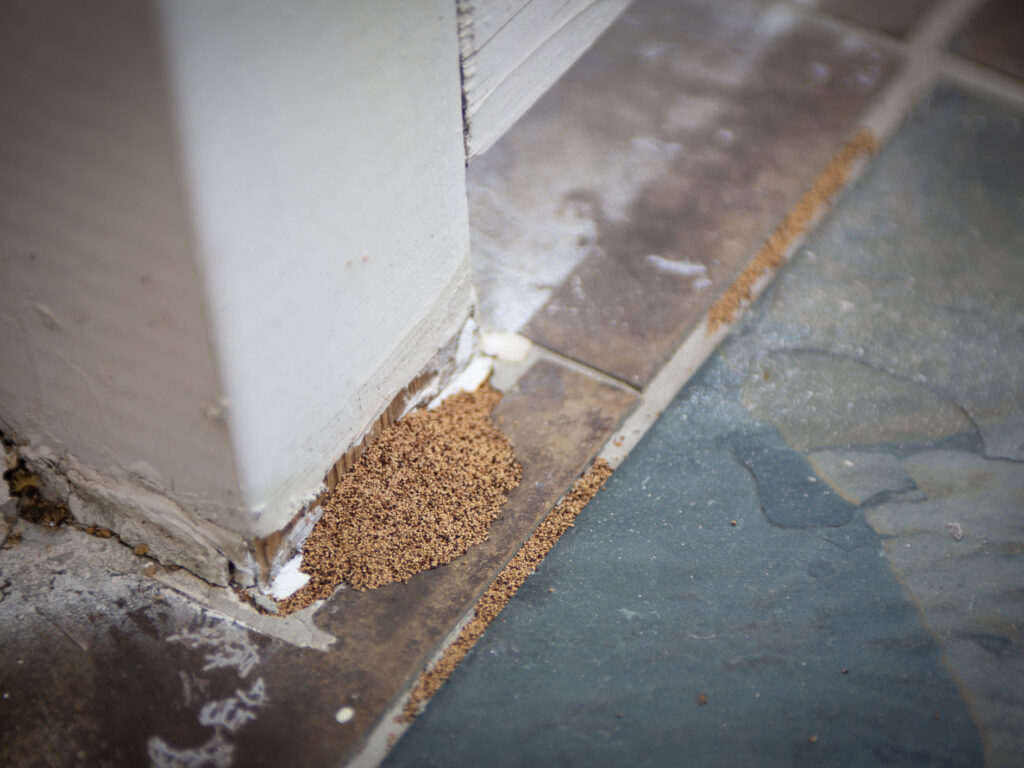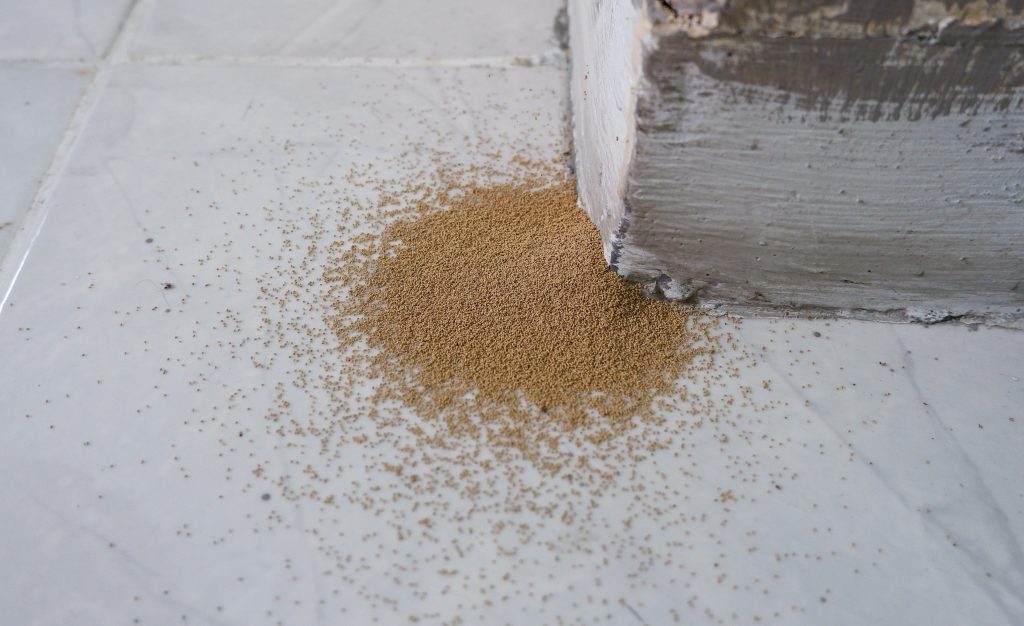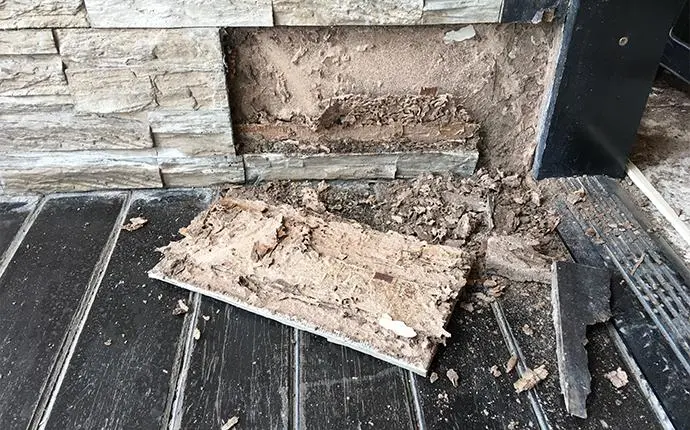No, termites cannot eat or digest concrete. Concrete is too complicated and lacks the cellulose termites needed for sustenance. They can, however, create mud tubes on concrete surfaces to reach other food sources.
Here’s why the termites can’t eat concrete:
- Concrete is too hard and dense for termites to chew or digest.
- Termites lack the necessary enzymes to break down the components of concrete.
- Concrete primarily consists of minerals and water, which provide no nutritional value to termites.
- Termites have evolved to feed on cellulose-rich materials like wood.
- Concrete’s composition does not align with termites’ dietary requirements.
- Termites are not adapted to penetrate or consume non-cellulose materials.
- Concrete’s physical properties make it an unsuitable food source for termites.
Myth: Termites can eat concrete

You might have heard the myth that termites can devour just about anything, even concrete. But before you start worrying about your home’s foundation becoming a termite buffet, let’s dig into the facts and debunk this misconception.
A. Why concrete is not a part of a termite’s natural diet
Termites are famous for eating things made of wood, paper, and cardboard containing cellulose.
Due to their specialized digestive systems, termites can digest cellulose found in wood, paper, and cardboard. However, concrete is entirely different.
Composition: Concrete consists of cement, water, and aggregates (like sand and gravel). These materials don’t have cellulose, which termites require for food.
Hardness: Concrete is incredibly hard and dense. Termites have soft bodies and delicate mouthparts that are adapted for chewing through softer materials. Attempting to eat concrete would be like trying to cut through steel with a plastic knife – it’s just not possible for them.
Lack of Nutritional Value: Even if termites could somehow breach the concrete’s surface, they would find no nutritional value within. Their digestive systems simply cannot extract sustenance from non-cellulose materials.
B. Debunking common misconceptions surrounding termites and concrete consumption
Now that we’ve clarified why termites cannot eat concrete let’s address some common misconceptions:
Tunnels in Concrete: Termites can create tunnels through concrete, but this is not the same as eating it. These tunnels, often called “mud tubes,” are constructed using a mixture of soil, saliva, and excrement.
They provide termites with a protected pathway to access their true food source – nearby wood or other cellulose-rich materials.
Concrete Damage: When termites are found in or around concrete structures, it’s typically a sign of an underlying issue.
They may have found their way into your home through cracks or gaps in the concrete, but they are not consuming the concrete itself. The real concern is that they may be using these access points to reach the wooden components of your home.
In conclusion, termites cannot eat concrete due to its composition, hardness, and lack of nutritional value.
However, they can create tunnels in concrete to access their preferred food sources, such as wood. If you suspect termite activity in or around your home, addressing the issue promptly is essential to protect your property from potential damage.
Threats of termites to structural integrity
A. Identifying potential damage caused by termites
Termites might be small insects, but they can wreak havoc on your home’s structure if left unchecked. Here are some key points to consider:
Weakened Support: Termites primarily target wooden structures. They burrow into the wood, consuming cellulose and weakening its integrity. Over time, this can compromise the structural support of your home.
Hidden Damage: Termites are often called “silent destroyers” because they work quietly and out of sight. Significant harm may have already occurred when you notice visible signs of termite damage, like sagging floors or hollow-sounding wood.
Costly Repairs: Fixing termite damage is costly, sometimes requiring major renovations. Regular inspections can find problems early and save you money.
B. Focusing on the specific materials termite target
Termites have a particular appetite for materials rich in cellulose. While concrete isn’t on their menu, these are the materials they’re most interested in:
Wood: This is termites’ favorite meal. They can devour wooden beams, furniture, and even the wooden framework of your home. Regularly inspect wooden structures for signs of termite infestation, such as small holes or sawdust-like droppings.
Paper and Cardboard: Termites also enjoy munching on paper and cardboard. If you store paper-based items in areas vulnerable to termite access, consider using sealed containers to protect them.
Fabrics: Some termites, like subterranean termites, may target fabric items, especially if they contain cellulose-based materials. Keep an eye on stored clothing and linens, especially in dark, humid areas.
Plant-Based Materials: Termites can damage your yard’s plants, shrubs, and trees. If these plants are close to your home, termites could potentially find their way inside.
In conclusion, while termites can’t eat concrete due to their composition, they pose a significant threat to the structural integrity of your home by targeting materials rich in cellulose, primarily wood.
Don’t underestimate the potential damage these tiny insects can cause – early detection and action can save you from costly repairs down the road.
Ensuring home protection against termite infestations

A. Preventive measures to deter termites from entering a property
Prevention and control are key when it comes to keeping your home safe from termite infestations.
In this blog section, let me dive into the measures you can take to protect your property from these pesky insects.
Maintain Proper Ventilation: Ensure good ventilation in crawl spaces and attics. Proper airflow can help reduce humidity, making your home less attractive to termites, as they thrive in moist environments.
Eliminate Moisture Sources: Fix any leaks or plumbing issues promptly. Termites are drawn to water sources, so keeping your home dry is essential.
Remove Wood-to-Soil Contact: Termites can easily access your home if wooden structures or landscaping touches the soil. Ensure a gap exists between the soil and any wooden parts of your house.
Regular Inspections: Schedule annual termite inspections by professionals. Early detection can prevent significant damage. Look for warning signs like mud tubes or damaged wood.
Use Termite-Resistant Materials: Choose termite-resistant materials like concrete, steel, or treated wood when building or renovating in areas prone to termites.
B. Effective termite control methods and treatments
Chemical Barriers: Termiticides can create a protective barrier around your home. These chemicals are applied to the soil around the foundation, deterring termites from entering. Professionals should handle this treatment.
Bait Systems: Termite bait stations can be strategically placed around your property. Termites eat the bait and take it to their nest, eliminating the infestation effectively.
Liquid Termiticides: Liquid termiticides can be applied directly to infested areas. They are an effective method for localized treatment.
Fumigation: For severe infestations, fumigation may be necessary. This involves sealing your home and introducing a gas that eliminates termites. It’s a highly effective but costly solution.
Wood Treatment: Protect vulnerable wooden structures by applying borate-based wood treatments. These chemicals deter termites and prevent infestations.
Regular Maintenance: Keep up with home maintenance. Repair any cracks in your foundation, seal gaps in walls, and replace damaged wood promptly.
Natural Predators: Encourage natural predators of termites, such as certain species of ants, to inhabit your yard. This can help keep termite populations in check.
In conclusion, termites can’t eat concrete but can harm your home’s structure by going after wood and similar materials.
Don’t wait until you see visible damage – take immediate action now to ensure your home remains termite-free.
FAQs
Can termites eat concrete?
No, termites cannot eat or digest concrete. Concrete is too hard and lacks the cellulose they need for sustenance.
Do termites damage concrete structures?
Termites do not consume concrete, but they can still cause damage by creating mud tunnels on the surface to access other food sources like wood.
How do termites damage concrete foundations?
Termites can enter cracks or gaps in concrete foundations and create shelter tubes on the surface, allowing them to reach nearby wooden structures.
Can termites weaken concrete structures?
No, termites cannot weaken concrete structures, as concrete is not a suitable food source for them.
Do termites prefer wood over concrete?
Yes, termites prefer wood over concrete as wood provides them with the cellulose they need for sustenance, whereas concrete lacks nutritional value for termites.
How can I protect my home’s concrete foundation from termites?
To protect your home, ensure that wooden components are not in direct contact with the ground or concrete, maintain proper drainage, and conduct regular termite inspections.
Are there termite-resistant concrete materials available?
Yes, signs of termite activity on concrete surfaces can include the presence of shelter tubes or mud tunnels constructed by termites as pathways to reach nearby wooden structures.
Do termites tunnel through other construction materials besides wood?
Yes, termites can tunnel through other construction materials besides wood, including drywall and insulation, if those materials contain cellulose, which termites feed on.
Conclusion
Termites cannot directly eat or digest concrete due to its composition.
However, they can cause structural damage to concrete structures by creating tunnels and accessing other cellulose-based materials, such as wood, through cracks or crevices.
While termites do not consume concrete, it is important to address any termite presence promptly and ensure proper maintenance to prevent them from accessing vulnerable areas and causing indirect damage.

